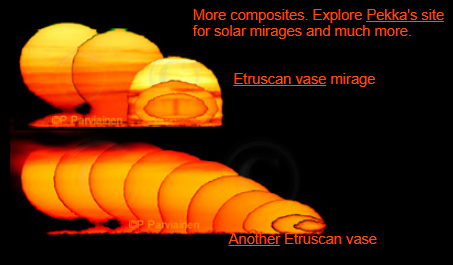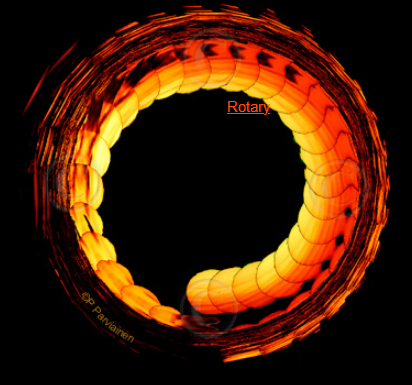Mirage Anatomy
Mirage Anatomy: Understanding the Phenomenon
Mirages are fascinating optical illusions that occur in the atmosphere, creating stunning visual effects. While many people have seen mirages in the form of shimmering water on a distant road, there is much more to their anatomy than meets the eye. In this article, we will delve deeper into the intricacies of mirages and explore their various manifestations.
Atmospheric optics photographer Pekka Parviainen has captured the progression of a solar mirage in a series of mesmerizing images. These images reveal the complex nature of mirages and how they can transform the appearance of the sun. As the sun sets through a temperature inversion layer, where warmer air overlays cooler air, inversions become fertile ground for mirages to occur.
Inversions can give rise to what is known as "mock-mirage" sunsets and "photographer's" green flashes. A single inversion can produce three solar images, with the sun appearing fragmented into multiple slices when multiple inversions are stacked. The top image on the left shows half of the solar disk sinking below the upper boundary of the inversion. The partial disc at the top is formed by rays that have grazed the inversion's temperature gradients and are strongly refracted, causing the solar disk to curve downwards and appear higher in the sky.
As rays pass deeper and across the inversion, they are refracted upwards relative to Earth's curvature, creating a second sun below the first. Moving from left to right in the series of images, we can observe not one but two solar slices within the inversion layer. This dual-slice phenomenon is quite common, with one slice being inverted and rising while the other descends.
The visibility and appearance of these mirages vary depending on the observer's height above the inversion layer. Inversion layers can be situated very close to the sea surface, and the most remarkable effects are often observed when the observer is not significantly higher than the inversion. When the observer is above the inversion, they can witness the captivating spectacle of multiple green or even blue flashes occurring on the uppermost sun. It's important to note that capturing these mock-mirage flashes through photography is generally easier than observing them visually.
While mirages can create stunning visual displays, it's essential to exercise caution when interpreting what you see. Mock-mirage flashes differ from the more intense final flash of an Etruscan vase or omega sunset, which are classic examples of mirage phenomena. Understanding the anatomy of mirages can help us appreciate the intricate interplay of light, temperature gradients, and atmospheric conditions that give rise to these captivating optical illusions.
In conclusion, mirages are not simply limited to shimmering water on a distant road. The anatomy of mirages encompasses a wide range of phenomena, including the fragmentation of the sun into multiple slices and the occurrence of mock-mirage flashes. By understanding the intricacies of mirages and the conditions necessary for their formation, we can better appreciate the beauty and complexity of these atmospheric optical illusions. So, the next time you witness a mirage, take a moment to marvel at the fascinating interplay of light and atmosphere that brings this captivating spectacle to life.

Three Sun Mirage ~ Renowned atmospheric optics photographer Pekka Parviainen (Polar Image) assembled this composite to show the progression of a solar mirage. All images ©Pekka Parviainen, shown with permission.



The sun is setting through a temperature inversion layer where unusually warmer air overlays cooler. Inversions are a ripe source of �mock-mirage� type sunsets and �photographer�s� green flashes. A single inversion can produce three solar images. The sun breaks up into multiple slices when several inversions are stacked.
At left in the top image, half of the solar disk has sunk below the inversion�s upper boundary. The upmost partial disc is from rays that have grazed the inversion�s temperature gradients and are strongly refracted to curve downwards - thus raising the solar disk in the sky. Rays passing deeper and across the inversion are refracted upwards relative to Earth�s curvature and create a second sun below the first. In images from left to right there are not one but two solar slices within the inversion layer. This is the norm, one is inverted and rises while the other descends.
These mirages are visible when the eye/camera is above the inversion. What is then seen varies much with height. Inversion layers can be very close to the sea surface and the best effects are seen when the eye is not much higher.
The uppermost sun can show multiple green or even blue flashes. Mock-mirage flashes are more easily photographed than observed visually (care!) compared to the more classical intense final flash of an Etruscan vase or omega sunset.
Note: this article has been automatically converted from the old site and may not appear as intended. You can find the original article here.
Reference Atmospheric Optics
If you use any of the definitions, information, or data presented on Atmospheric Optics, please copy the link or reference below to properly credit us as the reference source. Thank you!
-
<a href="https://atoptics.co.uk/blog/mirage-anatomy/">Mirage Anatomy</a>
-
"Mirage Anatomy". Atmospheric Optics. Accessed on April 25, 2024. https://atoptics.co.uk/blog/mirage-anatomy/.
-
"Mirage Anatomy". Atmospheric Optics, https://atoptics.co.uk/blog/mirage-anatomy/. Accessed 25 April, 2024
-
Mirage Anatomy. Atmospheric Optics. Retrieved from https://atoptics.co.uk/blog/mirage-anatomy/.